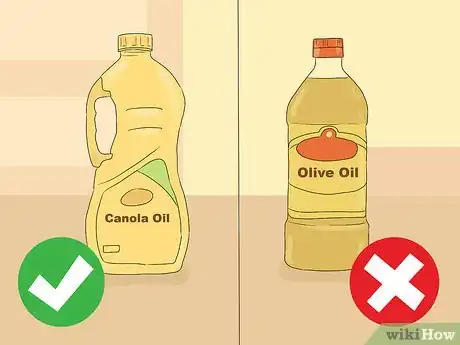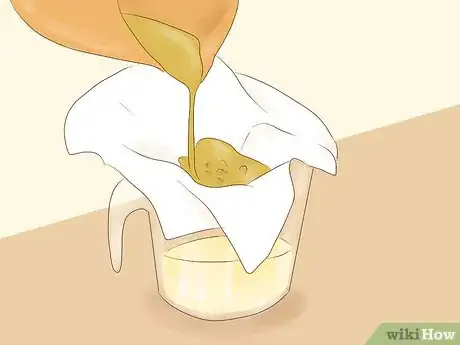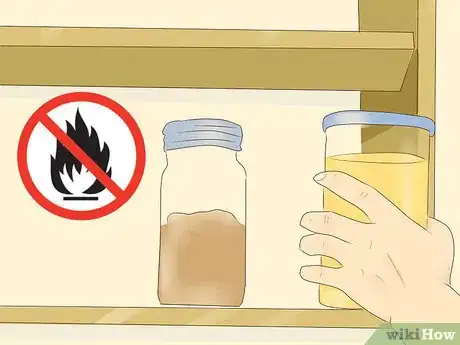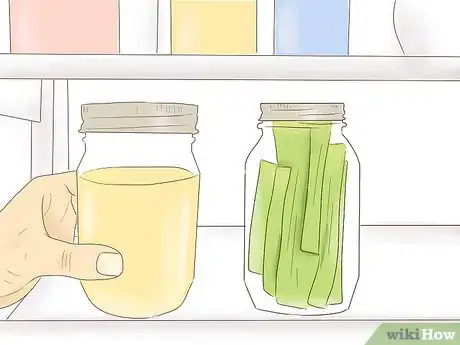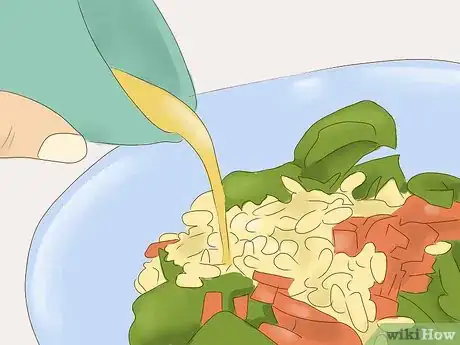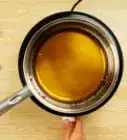This article was co-authored by Vanna Tran, a trusted member of wikiHow's volunteer community. Vanna Tran is a home cook who started cooking with her mother at a very young age. She has catered events and hosted pop-up dinners in the San Francisco Bay Area for over 5 years.
There are 8 references cited in this article, which can be found at the bottom of the page.
This article has been viewed 117,939 times.
Learn more...
Reusing cooking oil can be a great way to save on your grocery budget and to cut down on food waste in your home. If you want to reuse your cooking oil, you need to choose a high-quality oil with a high smoking point, and strain it through cheesecloth between each use. Store the used cooking oil in a cool, dry place in a sealed container.
Steps
Taking the Proper Precautions
-
1Choose a cooking oil with a high smoking point. If you want to be able to reuse your cooking oil, it’s important that you start off with a cooking oil that is worth reusing. Choose a cooking oil with a high smoking point, preferably at or above 400° F (204° C). A higher smoking point means your cooking oil will last better under higher temperatures and is more likely to be able to be reused.[1]
- Try using canola, avocado, sesame, sunflower, or grapeseed oils. Each of these has a different taste, so you'll want to see which one you like best.[2]
- Avoid using olive oil, as it has a low smoking point, and doesn’t readily lend itself to reuse.
-
2Let the oil cool. Don’t try to store your used cooking oil until it has completely cooled off. As soon as you are finished using the oil, turn off the heat source and let the oil sit (overnight if necessary) before you try to transfer it into a container for storage.[3]
- If you leave the oil out overnight, be sure to cover it with something to keep it from getting inadvertently contaminated.
Advertisement -
3Filter out the unwanted leftovers with cheesecloth. Whenever you use cooking oil, there will always be something left behind that you don’t want to leave lying around in the oil. This might include breading crumbs, loose batter, or extra fat.[4]
- To get rid of these extras, you can filter them out by running the oil through a cheesecloth.
-
4Place the cheesecloth over a clean open container. Make sure you place the cheesecloth on top of a clean container that can hold the filtered oil. Pour the oil onto the cheesecloth and let the clean oil spill into the new container. This will help you avoid making a big mess.
- Remember to never pour cooking oil down the drain. This can cause clogs and other damage to your pipes over time.
Storing the Oil for Reuse
-
1Keep it in a sealed container. If you want to reuse your cooking oil, you need to keep it from being compromised. The best thing to do in this case is to keep the oil in a sealed container. You don’t want any food or dust particles (or worse, insects!) getting into the oil you’re planning on reusing.[5]
- The best containers for oil storage are glass jars, or the bottle the oil originally came in (if it is empty).
-
2Store the oil away from heat sources. Many people keep their old cooking oil near the stove. This is actually one of the worst things you can do, as exposure to heat will make your oil break down much faster. Keep your oil in a cool place away from any possible contact with heat sources – like the stove, oven, microwave, heating vent, or even in direct sunlight from a window.[6]
- Consider keeping your used cooking oil in the back of a pantry or cabinet, or even in the garage (if it’s not too hot in there).
-
3Store the used oil in the refrigerator. You may even want to consider storing your leftover oil in the fridge if you think you will keep it for more than a week. This will help slow down any potential bacteria growth and allow you to reuse the oil for longer.
- Remember to keep it in a tightly sealed container, even in the refrigerator.
-
4Keep it in a dark setting. Bright lights and direct sunlight can cause your cooking oil to deteriorate more rapidly. In order to avoid this, you should store your used cooking oil in dark locations, out of reach of direct sunlight.[7]
- Inside of a pantry, cupboard, or cool garage would be an ideal location for your used cooking oil.
Reusing the Oil
-
1Reuse the oil with similar food items. Remember that your cooking oil will be flavored by whatever food you are cooking in it. This means that you should only reuse cooking oil with other foods that have a similar (or at least compatible) flavor.[8]
- For example, if you used the cooking oil to make fried chicken, you could easily reuse it to fry up some potatoes. But you might want to avoid reusing that cooking oil if you’re planning on making doughnuts.
-
2Use it for various purposes. Don’t feel like the only thing you can use cooking oil is for deep frying. If you’ve got a batch of cooking oil you want to reuse, feel free to take a little bit out of the stash here and there.[9]
- You can reuse the oil to add to a stir-fry or a pasta salad.
- Just be mindful of reusing oil with a new food that has a compatible flavor.
-
3Toss the oil when it shows signs of spoilage. Reusing cooking oil can be a great way to save money and minimize household waste. However, cooking oil can only be reused so many times before the particles start to break down. So it’s important to know when your oil has reached that point.[10]
- If your cooking oil starts looking thick, gummy, cloudy, darker in color, has foam on top, or begins to smell rancid, it’s time to dispose of it.
- No matter what precautions you take, you should always throw out cooking oil that is more than six weeks old.
Community Q&A
-
QuestionCan I pour cooking oil down the sink?
 wikiHow Staff EditorThis answer was written by one of our trained team of researchers who validated it for accuracy and comprehensiveness.
wikiHow Staff EditorThis answer was written by one of our trained team of researchers who validated it for accuracy and comprehensiveness.
Staff Answer wikiHow Staff EditorStaff AnswerNo, this is not recommended at all. Cooking oil or fat poured down the sink can solidify and clog the pipes, causing you to have to get a plumber. Even if it doesn't clog your pipes, it can join with other oils and fats and clog the civic sewer system. That might not seem like your problem––until your rates go up and local wildlife suffers from poor water quality. Instead, keep aside old jars to pour oil into. Once filled, the jar can be disposed of in your usual trash waste.
wikiHow Staff EditorStaff AnswerNo, this is not recommended at all. Cooking oil or fat poured down the sink can solidify and clog the pipes, causing you to have to get a plumber. Even if it doesn't clog your pipes, it can join with other oils and fats and clog the civic sewer system. That might not seem like your problem––until your rates go up and local wildlife suffers from poor water quality. Instead, keep aside old jars to pour oil into. Once filled, the jar can be disposed of in your usual trash waste. -
QuestionCan cooking oil be put into a compost bin?
 wikiHow Staff EditorThis answer was written by one of our trained team of researchers who validated it for accuracy and comprehensiveness.
wikiHow Staff EditorThis answer was written by one of our trained team of researchers who validated it for accuracy and comprehensiveness.
Staff Answer wikiHow Staff EditorStaff AnswerYes but only in small amounts over a long period of time. First, make sure it is just vegetable oil and nothing else (e.g. safflower, sunflower, olive oils, etc.). Second, only add small amounts of oil now and then. If you pour in too much vegetable oil and do so frequently, the compost won't decompose well as the oils will clog it all up. After adding, stir well to ensure it is evenly distributed across the compost.
wikiHow Staff EditorStaff AnswerYes but only in small amounts over a long period of time. First, make sure it is just vegetable oil and nothing else (e.g. safflower, sunflower, olive oils, etc.). Second, only add small amounts of oil now and then. If you pour in too much vegetable oil and do so frequently, the compost won't decompose well as the oils will clog it all up. After adding, stir well to ensure it is evenly distributed across the compost. -
QuestionCan reused vegetable oil be stored at room temperature?
 wikiHow Staff EditorThis answer was written by one of our trained team of researchers who validated it for accuracy and comprehensiveness.
wikiHow Staff EditorThis answer was written by one of our trained team of researchers who validated it for accuracy and comprehensiveness.
Staff Answer wikiHow Staff EditorStaff AnswerYes, you can store vegetable oil slated for reuse at room temperature. Store in an opaque bottle or other container, preferably glass. Keep the stored oil away from direct light in a cool, dark cupboard or pantry. The bottle (or other container) must be sealed during storage. Do not subject to warm temperatures during storage.
wikiHow Staff EditorStaff AnswerYes, you can store vegetable oil slated for reuse at room temperature. Store in an opaque bottle or other container, preferably glass. Keep the stored oil away from direct light in a cool, dark cupboard or pantry. The bottle (or other container) must be sealed during storage. Do not subject to warm temperatures during storage.
References
- ↑ Vanna Tran. Experienced Cook. Expert Interview. 15 March 2019
- ↑ Vanna Tran. Experienced Cook. Expert Interview. 15 March 2019
- ↑ https://food52.com/blog/15155-how-many-times-can-you-reuse-your-frying-oil
- ↑ http://www.bonappetit.com/test-kitchen/how-to/article/leftover-frying-oil
- ↑ Vanna Tran. Experienced Cook. Expert Interview. 15 March 2019
- ↑ http://www.seriouseats.com/2013/09/ask-the-food-lab-how-many-times-can-i-reuse-fry-oil.html
- ↑ http://goaskalice.columbia.edu/answered-questions/reusing-cooking-oil-safe
- ↑ http://recipes.timesofindia.com/articles/features/-how-to-reuse-cooking-oil/articleshow/50695425.cms
- ↑ http://www.vegkitchen.com/tips/easy-ways-to-reuse-cooking-oil-so-it-doesnt-end-up-in-the-drain/
About This Article
If you want to reuse cooking oil, make sure you’re using canola or vegetable oil since it takes longer to break down. After you let the oil cool completely, pour it onto cheesecloth over a clean container to filter it. Once the oil drains into the container, seal it tightly and store it in the refrigerator and away from the light. When it comes time to reuse your oil, make sure you cook it with similar foods since the oil will have retained some flavor from the last thing you cooked. If the oil starts to look thick or darkens in color, throw it away because it has spoiled. If you want to learn what oils to avoid reusing, keep reading the article!
